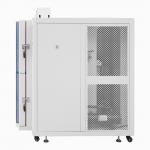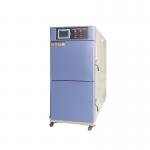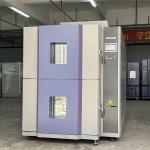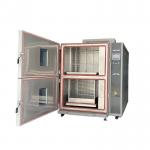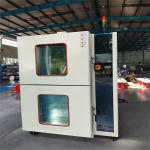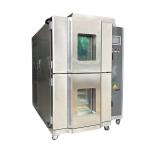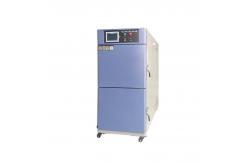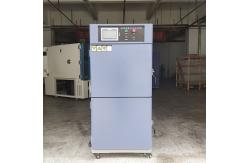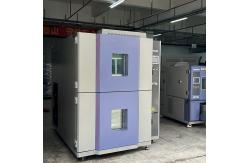In the highly competitive and innovation-driven semiconductor and
electronics industries, the Custom Thermal Shock Chambers,
engineered to meet JESD22-A106B, Thermal Shock test standards,
emerge as a game-changer in ensuring the quality and durability of
electronic components. This custom-built thermal shock chamber is dedicated to subjecting
a diverse range of semiconductor and electronic components, such as
integrated circuits, transistors, capacitors, and connectors, to
the exacting thermal shock testing protocol mandated by
JESD22-A106B. It serves as an indispensable tool for semiconductor
manufacturers, electronics design houses, and quality assurance
laboratories. The overarching objective is to evaluate the ability
of these components to withstand rapid and extreme temperature
transitions. By replicating the thermal shock conditions that
components may encounter during their manufacturing processes,
operational lifetimes, and in various environmental scenarios,
manufacturers can identify and rectify potential weaknesses,
optimize production processes, and enhance the overall reliability
and performance of their electronic products. - Robust and High-Performance Chamber Construction
- The chamber is constructed with heavy-duty, heat-resistant
materials that can endure the intense thermal forces. The walls are
fabricated from high-strength alloy steel, combined with advanced
thermal insulation layers to minimize heat transfer between the hot
and cold zones. The door is engineered with a precision sealing
mechanism and a viewing window, allowing operators to closely
monitor the testing process without compromising the chamber's
integrity. The interior is designed with custom racks and fixtures,
enabling the accommodation of a wide variety of component sizes and
shapes and ensuring uniform exposure to the thermal shock
conditions.
- Ultra-Precision Temperature Control and Cycling System
- Temperature Range and Cycling: Capable of achieving a wide
temperature range, typically from -80°C to +150°C. The system can
execute rapid temperature cycling between the hot and cold zones,
with a transition time as short as a few seconds. This is crucial
for mimicking the abrupt temperature changes that electronic
components may experience. The temperature control is accurate to
within ±0.2°C, providing highly reliable and repeatable test
results.
- Programmable Temperature Profiles: The chamber's control system
allows for the creation and execution of complex, custom
temperature profiles. Operators can define specific temperature
levels, dwell times in each zone, and the sequence and number of
thermal shock cycles to replicate a diverse range of real-world
manufacturing and operating conditions. This flexibility enables
comprehensive testing of components under different
mission-critical scenarios.
- Intuitive Control Panel and Data Acquisition Interface
- The control panel is designed for ease of use by semiconductor and
electronics engineers. It offers a user-friendly interface that
allows effortless setting and adjustment of all test parameters,
including temperature, cycling times, and component identification.
The panel also provides real-time displays of the current
temperature in both zones, the status of the testing process, and
any alarms or warnings. The chamber is integrated with a
comprehensive data acquisition system that records all relevant
test data. This includes detailed temperature histories, cycle
counts, and any observable changes in the electrical, physical, or
performance characteristics of the tested components. The data can
be stored in a secure, encrypted format in the chamber's built-in
memory or exported to external storage devices for in-depth
analysis and reporting. The system can also generate detailed test
reports in various standardized formats.
- Enhanced Safety and Security Features
- To ensure the safety of operators and the protection of sensitive
test samples and the chamber itself, a suite of advanced safety and
security features is incorporated. These include multiple layers of
over-temperature and over-current protection, emergency stop
buttons with redundant circuitry, and alarms for any abnormal
temperature fluctuations, equipment malfunctions, or security
breaches. The chamber is also equipped with access control
mechanisms, such as biometric authentication or smart card readers,
to prevent unauthorized access and safeguard classified testing
activities. Additionally, it has a self-contained fire suppression
system and proper ventilation and exhaust mechanisms to handle any
potentially hazardous gases or vapors that may be generated during
testing.
- Temperature Range and Accuracy
- The -80°C to +150°C temperature range with ±0.2°C accuracy offers a
comprehensive and precise testing envelope. Electronic components
often have strict temperature tolerance requirements due to their
complex internal structures and functions. For example, a
transistor's electrical characteristics can change significantly
with temperature, and accurate temperature control is essential for
evaluating its stability. The wide temperature range allows for the
assessment of components under both extremely cold and hot
conditions, ensuring compliance with JESD22-A106B.
- Thermal Shock Cycle Parameters
- The chamber can be programmed to perform a highly customizable
number of thermal shock cycles, ranging from a few dozen to several
thousand, depending on the specific requirements of the component
and its expected service life. The dwell time in each temperature
zone can be adjusted from milliseconds to hours, enabling the
simulation of a vast array of manufacturing and operational
scenarios. For instance, an integrated circuit used in a mobile
device may need to withstand short, frequent thermal shock cycles
during its use, while a component in a server may experience
longer, less frequent cycles.
|
